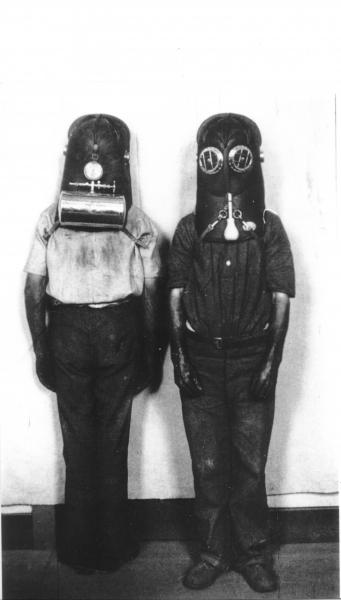Former Kalgoorlie Mining Associates property. a. Box contains "Two cylinders (AA) of 15 cubic feet capacity at a pressure of 120 atmospheres, [two] shut-off valves (BB) connected by a manifold (C). At each end of the manifold (C) is fitted a non-return valve which permits one of the cylinders to be removed from the apparatus without loss of gas from the other. To the manifold is connected a pressure gauge (D) which shows the pressure of the gas in the cylinder. To the other side of the manifold is connected a pressure reducing and control valve (E) fitted with a flow meter (F) calibrated in litres/minute. The flow of gas is controlled by rotating the tap (G). Rotation in a clockwise direction increases the flow and vice versa. From the reducing valve, gas passes via the pipe (H) to the metal connecting piece (I) to one limb of which is connected the flexible breathing bag (K) and to the other non-return valve (L) and the flexible breathing tube (M). A spring loaded non-return inlet valve (N) is fitted for the purpose described hereafter. To the end of the breathing tube is secured the rubber face mask (O). This is provided with a non-return outlet valve (P) and a variable admission port. (Q) [NB refer to diagram in supplementary file for letters] "TO USE THE "NOVITA" APPARATUS" Start artificial respiration without delay. 1. See that the control tap (G) is turned to its full extent in the anti-clockwise direction. 2. Open the valve (B) of one of the cylinders (A) (A) 3. Open the air admission port (Q) on the face mask (O). 4. Apply the face mask to the patient, pressing it into position so as to make a good joint. 5. Rotate the control tap (G) in a clockwise direction until the flowmeter (F) registers 10 litres per minute. 6. Close the air admission port (Q) on the face mask. 7. Watch the movements of the breathing bag (K). If this becomes overinflated reduce the flow of gas by rotating control tap (G). If the bag becomes deflated increase the flow of gas. 8. If the patient recovers to such an extent that he is consuming 30 litres per minute, open the air admission port (Q) on the face mask and reduce the flow of gas to 25 litres. If recovery is maintained reduce the flow and open the air admission port (Q) progressively, increasing the flow if respiration appears to fail. The purpose of the spring-loaded air admission valve (N) is to admit the atmospheric air if by chance the patient should empty the breathing bag." b. "HANDBOOK / OF / INSTRUCTIONS / FOR SUING THE "NOVITA" / RESUSCITATION / APPARATUS / TWO CYLINDER MODEL / Sole Manufacturers: SIEBE, GORMAN & CO., LTD. / NEPTUNE WORKS, / TOLWORTH, SURREY, ENGLAND c,d Paper labels, green and white. Both read; "CIG / OXYGEN 95% CARBON DIOXIDE 5% / (These percentages are subject to a tolerance) / contents .... Cubit Feet / COMPRESSED / CARBOGEN / CIG (WESTERN AUSTRALIA) PTY. LTD. / HAY STREET (West) SUBIACO / Telephone: W 2291 / USE NO OIL / OR GREASE". d. has bottom and top cut off. e. Spanner in torn calico bag f-h bolts, may be brass, have been painted. e-h appear to be used to shut off valve to change over bottles; they may not necessarily be part of the original kit, merely maintenance gear kept with original item for convenience. The fact they were donated as one item suggests this.
Department:
History DepartmentCollection
History Collection
Collection Item Data
| Accession Number: | H1989.764 |
|---|
| Accession Date: | 7 Aug 1989 |
|---|
Material
| Paper | Card, metal, rubber, paper, calico, painted metal [brass?]
|
|---|
Measurement
The WA Museum is in the process of digitising its collections. This record may not have been reviewed by curatorial staff and may be inaccurate or incomplete. Research departments are continually working on these collections by adding new objects and reviewing existing content when new information is made available.




